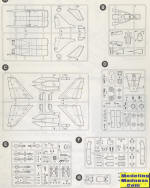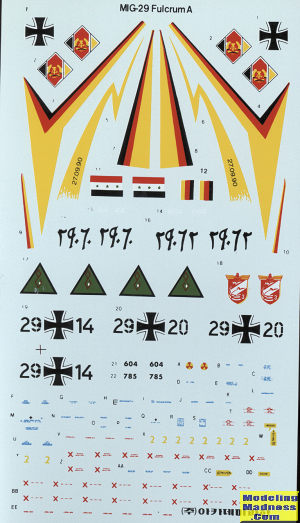
Academy 1/48 MiG-29A Fulcrum
| KIT #: | 2116 |
| PRICE: | about $25.00 for this boxing. Newer boxings around $35.00 |
| DECALS: | Four options |
| REVIEWER: | Scott Van Aken |
| NOTES: | 1993 tooling |

| HISTORY |
The Mikoyan MiG-29 (Russian: Микоян МиГ-29; NATO reporting name: Fulcrum) is a twin-engine jet fighter aircraft designed in the Soviet Union. Developed by the Mikoyan design bureau as an air superiority fighter during the 1970s, the MiG-29, along with the larger Sukhoi Su-27, was developed to counter new U.S. fighters such as the McDonnell Douglas F-15 Eagle and the General Dynamics F-16 Fighting Falcon. The MiG-29 entered service with the Soviet Air Forces in 1982.
While originally oriented towards combat against any enemy aircraft, many MiG-29s have been furnished as multirole fighterscapable of performing a number of different operations, and are commonly outfitted to use a range of air-to-surface armaments and precision munitions. The MiG-29 has been manufactured in several major variants, including the multirole Mikoyan MiG-29M and the navalised Mikoyan MiG-29K; the most advanced member of the family to date is the Mikoyan MiG-35. Later models frequently feature improved engines, glass cockpits with HOTAS-compatible flight controls, modern radar and IRSTsensors, and considerably increased fuel capacity; some aircraft have also been equipped for aerial refuelling.
Following the dissolution of the Soviet Union, the militaries of a number of former Soviet republics have continued to operate the MiG-29, the largest of which is the Russian Air Force. The Russian Air Force wanted to upgrade its existing fleet to the modernised MiG-29SMT configuration, but financial difficulties have limited deliveries. The MiG-29 has also been a popular export aircraft; more than 30 nations either operate or have operated the aircraft to date, India being one of the largest export operators of the type. In 2013 the MiG-29 was still in production by Mikoyan, a subsidiary of United Aircraft Corporation (UAC) since 2006
| THE KIT |
 Released in 1993, the MiG-29 kit was soon accepted by the modeling community
as the best in this scale, mostly because by then, model companies had access to
the actual airframes from which to take photos and measurements.
Released in 1993, the MiG-29 kit was soon accepted by the modeling community
as the best in this scale, mostly because by then, model companies had access to
the actual airframes from which to take photos and measurements.
However, any research falls a bit short when it comes to details in the cockpit. The tub includes a seat which is only vaguely similar to the actual ejection seat installed in the -29 so get a resin replacement. There is also a control stick and an instrument panel. This assembly fits into the upper section of the forward fuselage. The kit has the forward and aft fuselage in sections, both split horizontally. It may be worthwhile to assemble and upper and lower halves before joining them together. The separate forward section is to simply plug in the two seat forward section for the UB. The lower forward fuselage has two inserts in the front section and the radome is also two pieces.
The underside of the fuselage then gets a piece for the gear wells, the nose well being part of the lower forward part. While the kit instructions have you building up the landing gear, you may want to wait until after painting. There are also inserts for the upper intakes for the doors to be open or closed. In the same vein, you can only build the main intake doors closed, which is normal for on the ground. At the back of the fuselage you can pose the speed brakes open or closed. They are normally closed. One then builds up and attaches the engine exhaust.
 Wings are upper and lower halves with holes that will need to be opened for
all the pylons. In addition to three pylons per wing, you can install a
centerline fuel tank. The tailplanes and fins are single pieces with the fins
having extensions containing flare/chaff dispensers. For the pylons, you have
three different air to air missiles, a pair of R-27s, R-73s and R-60s. There are
also a number of sensors that are affixed to various places on the airframe.
Windscreen and canopy are separate items. You could pose the canopy open, but
there is no specific mechanism included.
Wings are upper and lower halves with holes that will need to be opened for
all the pylons. In addition to three pylons per wing, you can install a
centerline fuel tank. The tailplanes and fins are single pieces with the fins
having extensions containing flare/chaff dispensers. For the pylons, you have
three different air to air missiles, a pair of R-27s, R-73s and R-60s. There are
also a number of sensors that are affixed to various places on the airframe.
Windscreen and canopy are separate items. You could pose the canopy open, but
there is no specific mechanism included.
Markings are for four aircraft. One in with the Iraqi Air Force, one is a special 'farewell' scheme with the East German Air Force and you have two sets of serial numbers for the unified German Air Force. Decals are nicely printed and there are lots of aftermarket sheets for those who want something different.
| CONCLUSIONS |
This was not the first MiG-29 in this scale, and probably not the best, but it is readily available and at a reasonable price. Add to it that Academy kits are usually well engineered and fit well.
| REFERENCES |
https://en.wikipedia.org/wiki/Mikoyan_MiG-29
February 2019 Copyright
ModelingMadness.com. All rights reserved. If you would like your product reviewed fairly and fairly quickly, please
contact
the editor or see other details in the
Note to
Contributors.
Back to the Main Page
Back to the Review
Index Page
Back to the Previews Index Page